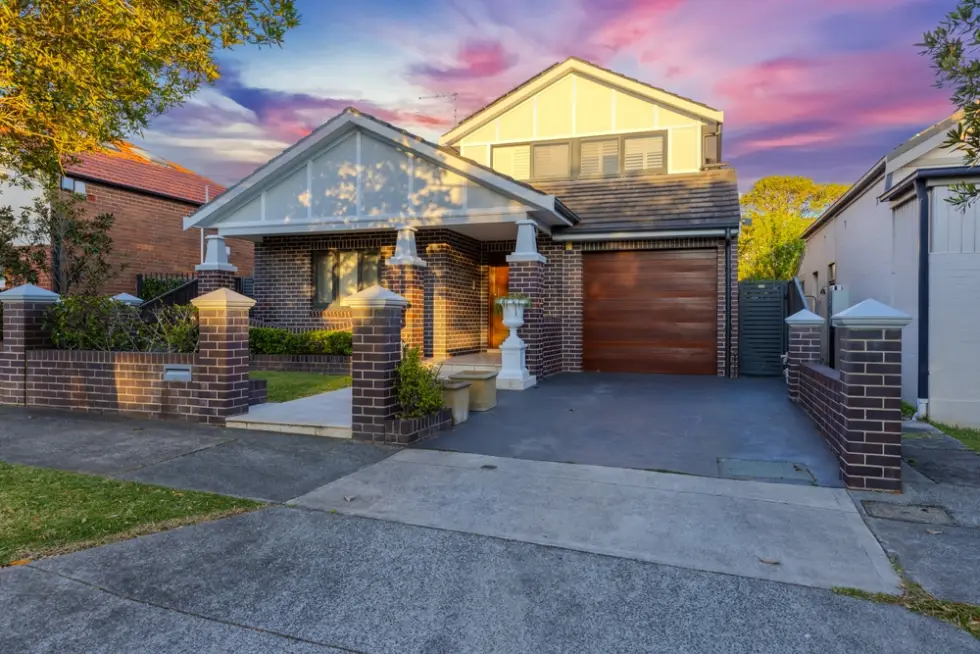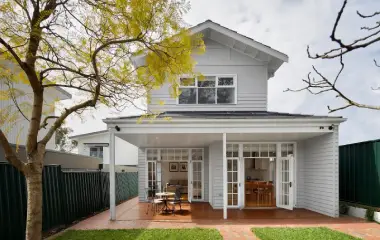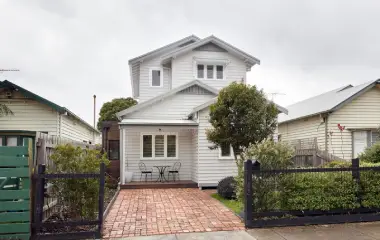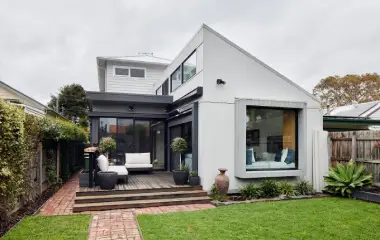If you’re planning an extension to your home — or buying with one in mind — you’re already thinking ahead. And you’re not alone. According to KPMG’s 2024 Renovation Domination report, renovation and extension activity now makes up 40% of all residential construction in Australia — with Melbourne leading the charge. And that’s a smart move. More and more Melbourne homeowners are skipping renovations and knockdowns in favour of smarter, targeted extensions that make the most of what’s already there.
But here’s the trick: not every house is built with future plans in mind. And the cost of an extension often starts with what you buy, not just what you build. At Supa Group, we’ve worked with families who made the right choice early — and a few who wished they had. So in this guide, we’ll show you how to spot the homes that are ready for your next chapter.
Where to start with planning house extension ideas
You’ve got the vision, now it’s time to reverse-engineer it. This section helps you define your goals so you can spot homes that support them, rather than stand in the way. From knowing what kind of living space you want to understanding what adds to the cost, we’ll walk you through where to begin.
What do you want your home to become?
Before you fall in love with a house, get clear on what you actually want to turn it into. Different types of house extensions suit different goals. Are you dreaming of more space for a growing family? An open-plan kitchen and living area that spills out into the garden? Maybe a second storey to future-proof your home, or a granny flat to give teenagers or grandparents their own space?
Whatever your vision, being specific now will help you identify properties that can bring it to life — and rule out the ones that will make it harder than it needs to be.
Why it matters before you buy
We’ve seen it before: a buyer falls in love with the location, only to realise the site isn’t suited to what they want to build. The result? Extra engineering, complex permits, and sometimes tens of thousands in additional costs.
If you know your ideal extension upfront, you can assess properties through that lens. You’ll spot layout limitations, tight boundaries, or tricky rooflines before they become your problem. And you’ll be in a stronger position to plan your future build and budget with confidence.
[feature_link]Looking forward to your build? Here are 5 things to consider when planning a house extension once you’ve found the right home.[/feature_link]
The best house types for extensions
Not all houses are created equal when it comes to extensions. Some layouts, structures, and sites make the process far easier and more cost-effective. Here, we’ll explore what kinds of homes are best suited to rear additions, second storey extensions, or self-contained units.
To learn more, watch this video where Supa Group’s experts explain how the right property choice sets the foundation for a successful extension.
Homes with strong rear extension potential
Looking to extend your living space out the back? Single-storey homes, especially weatherboard or brick veneer, with long, rectangular blocks are often ideal. They’re usually easier to open up at the rear, which makes them perfect candidates for adding open-plan kitchen, dining, and living areas.
If the backyard’s generous and the internal layout is relatively traditional, you’ve got room to play. These types of extensions are some of the most cost-effective and transformative you can do.
Homes suited for second-storey additions
Thinking vertical? Look for houses with solid bones, ideally on stumps, with a pitched roof and a floor plan that allows for clear separation between upstairs and downstairs zones.
These are the homes that make a double-storey extension smoother from a structural point of view. They’re particularly valuable in areas where land is tight and backyard space is worth preserving.
[feature_link]Are upper or lower extensions more expensive? Here’s what you need to consider.[/feature_link]
Multi-generational extension opportunities
If your dream includes a self-contained unit or granny flat, you’ll want to find a block with width and, ideally, side access. These kinds of multi-generational home extension types offer great lifestyle flexibility, whether you’re accommodating relatives, teenagers, or long-term guests.
They’re also a clever way to add long-term value without interfering too much with the main house. Just be mindful of local planning regulations, especially if the extension involves a separate entrance or bathroom and kitchen facilities.
Homes that can be tricky (but not impossible)
Some homes present more challenges than others. Flat-roof homes, slab-on-ground construction, or properties that have already been extensively renovated can limit what’s possible — or simply add to the cost.
Heritage-listed homes or those within overlay zones may still be extendable, but you’ll face more paperwork, more consultants, and potentially more time. These homes aren’t dealbreakers, but they are better approached with a full understanding of what you’re signing up for.
[process_video]
How the Supa Group process helps you choose smarter
If you’re buying a home with future plans to extend, our process doesn’t just start with sketches — it starts with strategic advice. We’ll help you assess the property’s strengths, identify red flags, and make confident decisions before you even make an offer.
Watch how our end-to-end process works — from pre-purchase guidance through to concept design, approvals and construction — all under one roof.
[/process_video]
3 things to look for in the block, not just the house

A beautiful house on the wrong block can become a very expensive mistake. This section shifts the focus to the land itself, because what’s around (and underneath) the house is just as important as what’s inside it.
1. Size and orientation
You’d be surprised how many people forget to check the basics. A home might be charming, but if the block is oddly shaped or the backyard is boxed in by neighbouring walls, you’ll be limited from day one.
Look for blocks with enough depth for ground-floor house extensions, and ideally a rear aspect that captures light. North-facing backyards are especially valuable, not just for liveability, but for energy efficiency and future resale.
2. Access for trades and machinery
This is a big one. Can a concrete truck, excavator or delivery van get to where they need to be? If there’s only narrow side access, shared driveways, or steep terrain, your build may take longer and cost more.
It’s one of those practical details that’s easy to overlook until your builder tells you it’s going to affect your budget.
3. Local council zoning and restrictions
Before you buy, it’s worth understanding what kind of overlays or restrictions apply to the property. Is it in a heritage area? Bushfire zone? Floodplain? Each of these will influence what kind of extension you can do, and how long approvals will take.
A quick chat with your local council or a design-and-construct builder like Supa Group can help you identify any red flags before you commit.
[feature_link]Not sure how zoning or overlays might affect your plans? Learn more in our guide: Do you need a permit for your home extension or renovation?[/feature_link]
7 red flags that make building a home extension harder
Some homes look perfect on paper until you dig into the details. Here are seven common red flags to look out for when assessing whether a property will support your future extension.
Some of these issues can be worked around — others might be deal breakers. If you're unsure where a property stands, it's worth booking a consultation with a building designer or design-and-construct builder before you commit. A quick site review can help you understand what's feasible, what's risky, and whether your vision is a good match for the home you're considering.
[threed_design][/threed_design]
How to find out if you can extend your house
It’s one thing to dream about the perfect extension, it’s another to know whether it’s actually doable. This section helps you inspect homes with the right lens, ask smart questions, and know when to call in expert advice before you buy.
What to ask when inspecting homes for extension potential
Look beyond the surface styling. Ask: can the internal walls be removed to create an open plan? Is the roof structure straightforward or complex? Are there plumbing or electrical limitations that could affect your build?
Also check for practical constraints like easements, drainage lines, or oddly placed sheds that could affect your footprint.
Oh, and some critical advice: it’s a very good idea to consider getting your own termite inspections and a structural report done. Trust us — picking up hidden problems this early will save you serious headache later down the road.
Who to speak to before you make an offer
Don’t just rely on the agent’s reassurance that “you can probably extend.” If you’re serious about buying with a build in mind, bring in a building designer or extension specialist before you sign.
A quick consultation with a design-and-construct builder like Supa Group can give you a realistic sense of feasibility, timing, and cost and save you from a costly surprise down the track.
Tools, checks and ballpark cost estimates
Run a title search to check for overlays, encumbrances or planning constraints. You can do this yourself, or ask a building designer or estimator to help. If you already have a rough idea of the extension you want, you may even be able to get a ballpark cost estimate.
We often work with clients before they buy, to help assess what’s doable and what’s going to stretch the budget. It’s a small step that can make a big difference.
[case_studies]
Real examples from Melbourne families
Want to see what a great extension looks like in real life? Explore our case studies to see how other homeowners chose the right property — and how we helped bring their plans to life.
[/case_studies]
Final thoughts: Buy smart now, so you can build smarter later
If you’re planning to build a home extension, the process doesn’t start with design — it starts with the purchase. The right property can open doors (literally) to future flexibility, better living, and greater long-term value.
At Supa Group, we can help you make those calls with confidence. Whether you’ve found a place you love, or you’re still early in your search, our team can help you understand what’s possible — and what’s not — before you buy.
[free_consultation]
Let’s review your plans and talk through what’s possible. Whether you’re buying soon or still exploring, we’re happy to help. Book now
[/free_consultation]
[tip_box]
FAQs and extra insights
What kind of questions should I ask myself at an open home if I’m planning an extension?
If you’re inspecting with an extension in mind, ask questions that go beyond the basics. Start with the structure:
- Is the house on stumps or a slab?
- Can internal walls be removed to create a more spacious layout?
- Is there evidence of water damage, poor drainage, termite damage or otherwise.
- Has any previous work been done that might complicate building an extension?
You’ll also want to check whether the home’s position allows for a side return extension or whether adding an extra bedroom or home office would feel cramped. Ask about:
- Easements or sewer lines
- Setbacks or overlays
- The size of the extension that might be allowed under council rules
Asking these questions can help ensure your dream home doesn’t come with hidden extension costs.
Is it better to buy an older home or a newer one for an extension?
It depends on the house and your vision. Older homes, like a traditional home, crafts home, or Victorian home, often sit on larger blocks with better access and clearer boundaries. That makes them ideal for:
- Rear or side and rear extensions.
- Adding skylights or windows for added natural light and ventilation.
- Opening up closed-off floor plans to create a larger, light-filled, modern space.
Newer homes can be energy efficient and require fewer structural updates, but they may limit your extension options due to:
- Narrow blocks or limited width of the plot
- Close proximity to neighbouring buildings
- Slab-on-ground construction
If you want flexibility to transform your home in future, the best type of home may be one with generous proportions, a clear roofline, and a block that gives you options.
What makes a home easier to extend?
From a builder’s perspective, homes that make extensions easier tend to offer:
- A flat or gently sloped block
- A large backyard or undeveloped garden
- Stump foundations and brick veneer construction
- Space for an extra bedroom or family zone without dramatically altering the original structure
Other features that help:
- Double-storey ceiling heights, which allow for natural light and ventilation
- Clear access from the street to the build zone
- An internal layout that makes it easy to create a seamless extension
These elements help reduce complexity, keep costs down, and make your home feel more spacious and cohesive once extended.
Should I factor in sunlight and orientation when choosing a property?
Yes — orientation and access to light are critical to building a home that feels warm, bright, and connected to the outdoors. For example:
- A north-facing rear yard is ideal for a light-filled garden room, kitchen, or dining space
- A glazed extension on the northern or eastern face can make your home feel bigger and more welcoming
Sunlight doesn’t just affect mood — it affects layout, glazing choices, and overall energy efficiency. If you're considering a sunroom or glass extension, orientation could make or break your design.
How do I know if my extension ideas will suit the existing structure?
There are some beautiful house extension ideas in Australia, but not all of them work on every home. To ensure your new extension is the right fit, consider:
- The height and shape of the roof
- Whether the internal layout supports a flowing design
- If the original house can structurally support your plans
A great designer can help you adapt your ideas to suit the home’s proportions and style, whether that means a modern addition to a Victorian house extension or a side return for a semi-detached house.
At Supa Group, we’re master builders and designers who know how to bring your ideas to life in a way that complements your existing house, adds value to your property, and supports modern family life.
[/tip_box]

















